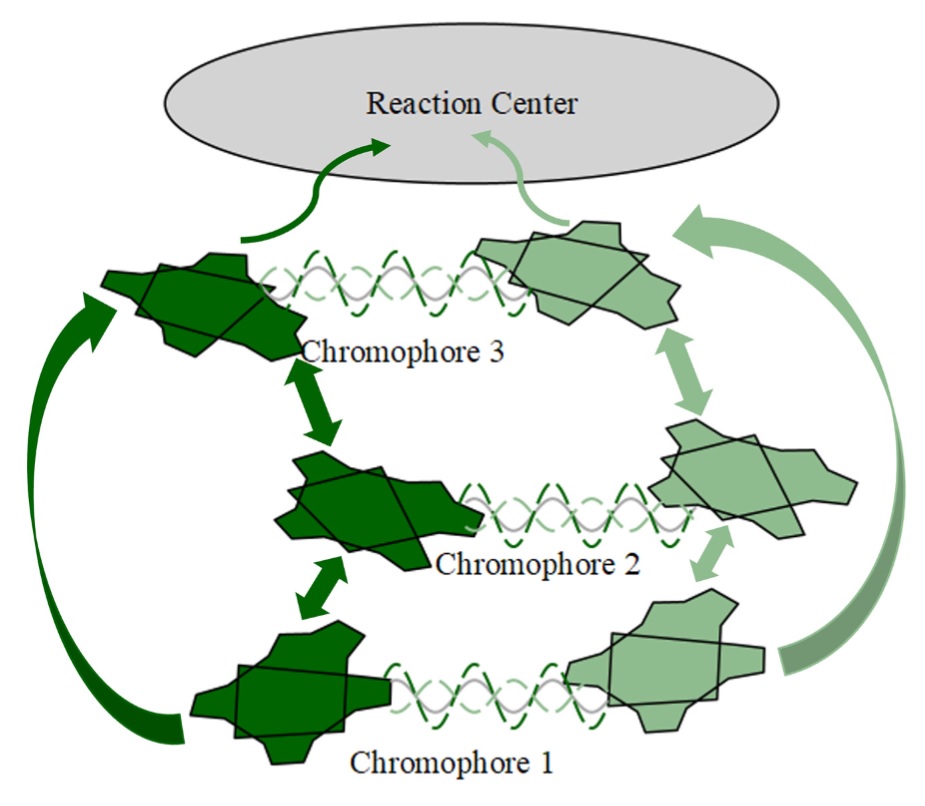Why is Energy Transfer in Photosynthesis So Efficient?
May 10, 2023
Numerical simulations have found that excitons can become a BEC -Bose Einstein Condensate- and this mechanism would explain the high efficiency of energy transport in photosynthesis of plants. The exciton-condensate mechanism could be harnessed to enhance energy transfer in synthetic systems.
By Dr. Inés Urdaneta, Physicist at Resonance Science Foundation
Photosynthesis is an extremely efficient biological process in plants, algae, and some types of bacteria, that utilizes light energy and carbon dioxide (CO2) to produce oxygen (O2) and chemical energy stored in glucose (a sugar).
Numerical simulations are showing that Bose Einstein condensates may be the key for such a high efficiency, and this phenomenon challenges what modern physics defines as possible regarding fundamental mechanisms in biological systems as it implies a quantum process that is not expected to happen at room temperature and in disordered (noisy) conditions that potentially degrade any quantum behavior.
Bose Einstein condensates -abbreviated as BEC- are considered a fifth state of matter; these are very exotic states of matter that are typically formed when a collection of separate atoms or subatomic particles at very low densities is cooled to temperatures very close to absolute zero (−273.15 °C), condition at which a large fraction of these entities occupy the lowest quantum state simultaneously. By doing so, their wave functions overlap, and they behave as a single entity macroscopically. It is as if they became a single atom; they all share the same quantum state and behave as a single entity.
This is to say that these initially distinguishable particles -also called fermions- obeying Pauli exclusion principle (meaning that they tend to reject each other and therefore can’t occupy the same quantum state) become indistinguishable when they occupy all the same quantum state, behaving then as bosons instead of fermions. The difference between fermions and bosons relies on their spin, bosonic particles (such as photons) have integer spin (0,1,2,…), while fermions have fractioned spin (1/2, 3/2 ..). Bosonic particles can overlap since they don’t reject each other. They can occupy the same quantum state and by doing so, they become indistinguishable from each other.
BECs present a very special feature; zero friction, and this last relates to two remarkable phenomena: superfluidity (implying zero viscosity) and superconductivity (implying zero electric resistance in charge transfer). A superfluid can for instance, climb up the walls of a recipient, while a superconductor can transfer electricity without any energy loss as thermal heat.
As we know, biology is composed of living forms at room temperature. Under such conditions, scientists would not expect superconductivity or superfluidity happening in such biological systems, because the fundamental particles composing biomass -atoms / subatomic particles such as electrons and protons- are fermions in ambient conditions.
The research performed by Schouten et al. is showing that nature has clever ways of bypassing such limitations. In this case, by the pairing or entanglement of two subatomic particles involved in photosynthesis -electrons and holes- that create a quasiparticle called exciton with zero net spin (i.e., a boson) out of the two initially fermionic particles. This happens because electrons and holes (vacancies denoting the lack of electrons at the places where they were prior to excitation by absorption of light, and that act as positive charges) have opposite spins, such that when they combine, the resulting exciton has zero spin.
The research team found that these excitons can become a BEC at room temperature. Like other condensation phenomena, exciton condensation leads to superfluidity of excitons and because excitons transport energy rather than charge or mass, this energy transfer is superfluid or friction-less. This is why the energy transfer in photosynthesis is so efficient.
Light-harvesting complexes involved in photosynthesis, transfer energy in the form of excitons created by the photo-excitation of an electron by sunlight. An electron absorbs a photon from light, and excites into a different quantum state, leaving a hole at that former location, which is now entangled to the original electron. These entangled pairs or excitons are transported through a series of light sensible regions of molecules -called chromophores- that act like molecular wires to transport this energy to a reaction center where this energy is collected for diverse biological functions, like sugar production. A chromophore is the part of a molecule that is responsible for its color.
Utilizing a theoretical model that explicitly introduces strong electron correlations in the form of intra-chromophore coupling, authors of this research explore the energy transfer and exciton condensation in microscopic biological systems under ambient condition. They expand the usual single-site model used for the chromophore complex, and that can only address interchromophore couplings, to a model with multiple electron sites on each chromophore, what allows for intra-chromophore couplings and creates additional channels for exciton transfer, where the coupling between the sites on the chromophores can be tuned using a coupling parameter.
Depending on the amount of coupling, researchers find that such parameter tunes the quantum interference to either a more constructive or more deconstructive case, what in turn enhances or decreases the rate of exciton transfer, respectively. They show the effect that the nature of the initial excitation state -entangled or local- and the number of sites per chromophore has on the rate of exciton transport. Increasing the number of sites per chromophore enhances exciton transfer.
 FIG. 1: Two pathways represented by the two sites of each chromophore. When interchromophore cross-site coupling ξ = 0, there is no cross-site interchromophore coupling. When the coupling parameter, V > 0, there is coupling, resulting in quantum interference between the sites of each chromophore. The waves demonstrate that quantum interference can be either constructive or destructive, with constructive interference enhancing the energy-transfer efficiency. Caption and figure taken from [1].
FIG. 1: Two pathways represented by the two sites of each chromophore. When interchromophore cross-site coupling ξ = 0, there is no cross-site interchromophore coupling. When the coupling parameter, V > 0, there is coupling, resulting in quantum interference between the sites of each chromophore. The waves demonstrate that quantum interference can be either constructive or destructive, with constructive interference enhancing the energy-transfer efficiency. Caption and figure taken from [1].
Authors also find that via this mix of inter- and intra- couplings, the model exhibits a signature for exciton condensation in the single-excitation manifold which evolves with the dynamics of exciton transport. The signature results from a combination of inter- and intra-chromophore exciton entanglement and depends on the initial excitation state and number of sites per chromophore.
RSF in perspective-
These remarkable results demonstrate a link between the enhanced exciton transfer and the exciton-condensation-like mechanism, showing that electron correlation and entanglement within the chromophores significantly increase the efficiency of energy transfer by creating additional pathways or channels for transfer. This also hints into the mystery of how biological systems can function so efficiently at ambient conditions.
Neg-entropic (i.e., ordering) processes happening in seemingly highly entropic environments, have always defied our comprehension of nature, and it rests as one of the main mysteries in science. One then wonders if what we consider a noisy state or disordered environment is a misunderstanding given our limited knowledge of how biological systems process the information/energy to self-organize in such highly ordered and extremely complex structures.
The work by Schouten et al. also shows that collective and highly coherent behaviors which in general are considered rare exotic phenomena even at very low temperature -such as quantum entanglement and BEC's- in reality happen regularly in biological systems, through mechanisms that we are still far from grasping from the standpoint of modern physics.
From the Unified Physics perspective, based on Nassim Haramein's Planck Plasma model and Generalized Holographic theory [2-5], entanglement is not only possible, but it is the siege of organization of matter in the universe since the Planck plasma is an entanglement network through which the information flows across scales. The sections where this flow is screened establish boundary conditions that we call proton, electron, etc.
The network of wormholes coordinates the organization of matter in the universe, from molecules, cells and organisms up to solar systems, galaxies and super-clusters. For more on Haramein's Unified Field theory, stay tuned for the upcoming Universal Scaling law paper that explains the entire mechanism for mass, forces and fields to emerge from the quantum vacuum plasma dynamics. The theory predicts all fundamental constants with at least 12 significant figures and the relationship between them is made explicit.
References
[1] Anna O. Schouten et al. 2023. Exciton-Condensate-Like Amplification of Energy Transport in Light Harvesting. PRX Energy 2 (2): 023002; doi: 10.1103/PRXEnergy.2.023002
[2] Haramein, N., Rauscher, E.A., and Hyson, M. (2008). Scale unification: a universal scaling law. Proceedings of the Unified Theories Conference. ISBN 9780967868776
[3] Haramein, N. (2012). Quantum Gravity and the Holographic Mass, Physical Review & Research International, ISSN: 2231-1815, Page 270-292
[4] Val baker, A.K.F, Haramein, N. and Alirol, O. (2019). The Electron and the Holographic Mass Solution, Physics Essays, Vol 32, Pages 255-262.
[5] Haramein, N & Val Baker, A. K. F. (2019). Resolving the Vacuum Catastrophe: A Generalized Holographic Approach, Journal of High Energy Physics, Gravitation and Cosmology, Vol.05 No.02(2019), Article ID:91083, 13 pages
